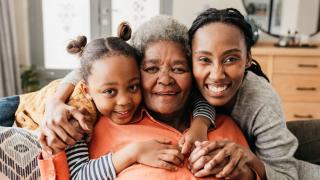
Raised in a small Minnesota town, this Mexican-German American grew up far from the vibrant hum of Latino culture. To most people, it was obvious I was different, but I didn’t really notice until people kindly (or maybe not so kindly?) pointed it out when I was little. A spark was lit, and I found myself curious about my identity. Ever since, I’ve been on a lifelong adventure to rediscover and reclaim the almost-forgotten traditions of my ancestors.
My Alvarez side has called San Antonio home since at least the early 1800s, maybe earlier, though history tends to get a little fuzzy that far back. We’re one of the families that can say, “We didn’t cross the border; the border crossed us.” Our roots stretched north from San Luis Potosí and Nuevo León, Mexico, with distant Andean ancestry woven in, likely from Peru. But like many families of the time, assimilation took its toll. Speaking Spanish became taboo and Catholicism took center stage. So even if I'd been closer to southern Tejas, I’m certain Día de (los) Muertos wouldn’t have been part of our lives until much more recently.
For decades, I read everything I could find about old practices. Then along came the internet, and I was able to connect with teachers of Curanderismo, the Traditional Healing Arts of Mexico. That’s when my yearly Day of the Dead celebrations truly began. I started painting my face like the elegant Catrinas. You know the ones: those fancy, iconic, satirical skeletons draped in aristocratic European clothing. I erected a small ofrenda, Spanish for “offering", an altar adorned with photos of the only people I knew who had passed: a couple of dear friends who left this life far too soon.
As time went on, more of those I loved journeyed to the next realm. With a heavy heart, I added my little brother to the ofrenda. In time family members followed: aunts, grandparents, and most recently, my dad.
The ofrenda morphed from a simple tabletop display to a full-blown art installation alive with flowers, candles, and monarch butterflies. Honoring the religious traditions of my family and also a distinct part of many traditional ofrendas, the top tier features graceful images of Our Lady of Guadalupe, nestled beneath an arch of cempasúchil, Aztec marigolds. Skulls abound! Some spun from sugar, others sculpted from clay or carved from stone. Colorful alebrijes, fantastical animal creatures that guide souls in the afterlife, stand guard. My favorites? The fierce jaguar and the dynamic hummingbird. I'm still on the hunt to find the world’s cutest Xoloitzcuintle (“Xolo” for short), the sacred dog of the Aztec underworld.
Whenever I’m in San Antonio, Mexico, or a Minneapolis mercado, I pick up a little treasure to add to my collection. I could go on forever about the other traditional touches—sea salt, water, mirrors, papel picado—but these are the ones that hold the deepest meaning for me.
I install the altar early so I can bask in the glow for weeks throughout October. As the days roll closer to the celebration, new treasures find their way onto the altar, and the flowers get lovingly refreshed. On the night itself, the real magic begins, and the provisions come out. Tequila, tamales, and mole for my great-grandpa, grandpa, and brother. My grandma gets her classic bottle of Budweiser. And for my dad, diet cherry coke (with extra extra cherries), fresh watermelon, and a bowl of menudo.
My German Seidl grandpa gets chewing tobacco (don’t worry, it can’t hurt him now, but that strong scent lures his spirit near) and Braunschweiger, which to my surprise, is delicious. I make sauerkraut with ham hock just like my grandma did. For the Italian relatives, homemade San Marzano sauce and pasta, and Grandma Perizzelli gets a glass of anisette. Favorite wines are poured, and even though mixing red and white feels blasphemous, everyone gets their favorite, and we don't judge. For the Wisconsin Germans, it’s pot roast and potatoes, hearty enough to feed both the living and the dearly departed.
We spend October cooking and freezing meals for our family, except for the tomato sauce, which gets made fresh during tomato season at the farmer’s market in late summer. And every year we stock up on the cherished elixirs.
Our official celebration is usually small: just me and my partner, and sometimes one or both of our adult daughters. This is the first year we've invited extended family as no one celebrates this holiday except us. I can't wait to see the photos they bring and to taste the dishes they contribute. We made a Spotify playlist of songs that remind us of our ancestors -- a compilation of everything from mariachi and Freddy Fender to Lawrence Welk and the Animals’ House of the Rising Sun. It’ll play as we gather, while copal smoke fills our home with the sweet scent of ritual and heritage.
We'll feast, toast, and reminisce. And if we’re lucky, maybe those familiar faces will visit us in our dreams that night. But even if they don’t, this celebration is a beautiful reminder that their spirits live on, tucked away safely in our hearts, forever ours.
About the author

Charlotte Alvarez, L.Ac., MOM, Dipl. OM, FAIHM (she/her/ella) is a nationally board-certified Acupuncturist and Herbalist providing holistic patient care rooted in both evidence-based medicine and the time-honored wisdom of ancient healing traditions. Currently seeing patients at the Whittier Clinic, she also serves as a Fellow of Health Equity and Social Justice within the Department of Medicine and is alumna of the Academy of Integrative Health and Medicine. She has been a dedicated collaborator in several Integrative Health programs and grant initiatives, including Heals on Wheels, Wellness on Wheels, Integrative Pain Management ECHO, and Group Medical Visits. Most recently, she joined the Latinx Collective Leadership Team, deepening her commitment to advocacy and fostering connection among Latine employees.
For nearly three decades, Charlotte has studied indigenous traditions from around the world, embracing Curanderismo (the Traditional Healing Art of Mexico), Aztec, Mayan, and Sapara cosmologies, Classical Chinese Medicine and philosophies, Igbo medicine, and Hawaiian spirituality.
Charlotte strives to empower individuals on their quests for wellness, while championing a Whole Person model in mainstream healthcare. Her multifaceted approach and global perspective ensure her work is culturally competent, socially responsive, and clinically transformative.



